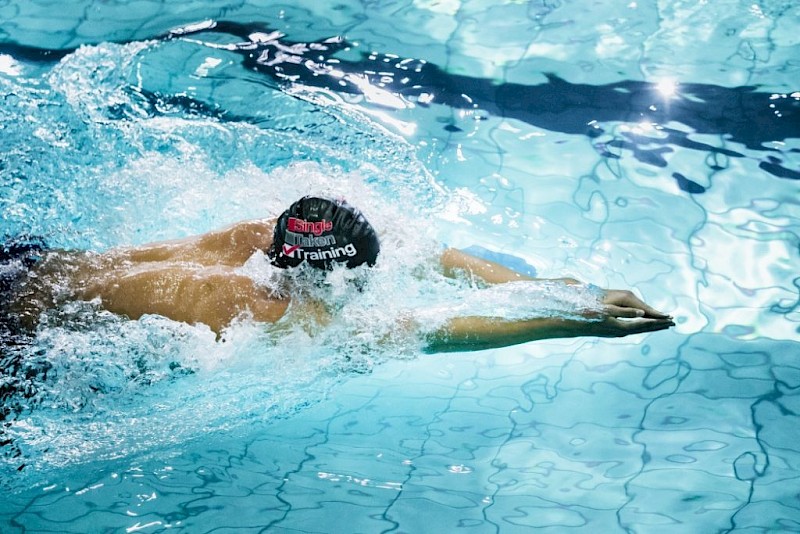'If you don't breathe you don't live, if you breathe wrong you live wrong': this applies to all human beings on land, let alone in the water. Breathing in freestyle is perhaps the most complex to structure because it requires a perfect fit of rhythms and movements.
Setting a correct breathing rhythm is therefore the first step to take in order to establish a pleasant (or at least acceptable) confidence in the water.
- breathing in water
- water resistance
- exercises for learning to breathe
- breathing in the freestyle
Breathing in the water
Correct breathing in water is an obstacle for many people to overcome because it is often hidden in the unconscious, perhaps linked to some bad memory from the past that has never been processed. From an unpleasant impact with the water in childhood, limits are unconsciously structured to the effectiveness of swimming and hindrances to a correct evolution of the technique, as well as to the awareness of one's gestures.
This bad memory manifests itself as a reflex dictated by the survival instinct which, on a mechanical level, translates into the inability to breathe correctly.
In any case, whatever the cause, what is important is to be able to identify the problem and intervene with effective solutions.
Water resistance
At an unconscious level, the human being in water identifies inhalation as 'good' and exhalation as 'bad'. Throwing out air, in fact, is processed as a 'loss' and so exhalation occurs almost by accident, in an ineffective way.
In practice, what you think you are doing is not exactly what you actually do. It is not easy to develop a path of awareness concerning truly effective breathing, and even more so to overcome old psychological blocks. But it is not impossible.
One must first become aware of what one is actually doing and compare it with what one thinks one is doing. To learn to blow hard, one must overcome both psychological (doing something 'bad') and physical resistance. The density of water, in fact, is about 800 times that of air. If this figure is hard to understand, just try putting your hand out of the car window when travelling at 100 km/h. However, the perceived (air-related) resistance is still far from that which water imposes, both on our body's forward movement and on the exit of air from our airways.
If exhalation in water is performed with the same low intensity with which we exhale in terrestrial life, it will never achieve the desired goal. It is therefore necessary to use the respiratory muscles with different intensities to achieve a useful exhalation. In short: you have to overcome water resistance!
Useful exercises for learning to breathe
To achieve the desired result, you can do
- basic breathing exercises, sitting or lying down, simply forcing the expiratory phase
- or you can use other swimming styles to become aware of the rhythms and movements. For example, one can swim breaststroke and set up breathing with a strong, long exhalation, taking care to keep the thumbs together in the stretching phase, then moving the hands together with the lifting of the head, to encourage a correct rhythm of the movement. If the thumbs do not stay together during the stretching phase, the stroke will start before the head is lifted and the exhalation will be shortened to almost nothing: the exhalation will be carried out hastily just before the inhalation, with the face already out of the water
- the backstroke can be used to set a breathing rhythm coordinated with that of the stroke. If, for example, in freestyle you breathe preferentially on the right side, during the backstroke style breathe in every time the right arm leaves the water, and breathe out every time the left arm leaves. The aim is to make breathing continuous and without blockages, so that the stroke is also continuous and without pauses.
It is breathing, therefore, that determines the rhythm of the stroke.
Breathing in freestyle
Once you have understood what you can and especially what you cannot do, you can try to apply some of the tricks developed in the previous exercises to the freestyle.
A small suggestion might be to perform a very short inhalation in the freestyle and a longer exhalation. If you breathe in every 2 strokes, the air to be stored will only be the air needed to get to the next inhalation: you do not need more.
Breathing becomes the metronome that gives the rhythm to the stroke and helps in the coordination of movements. When inhalation is excessive, the mechanism jams. If, for example, one thinks of inhaling excessively while running, the consequence is immediately apparent. The same thing happens when swimming: breathlessness is the result. Breathlessness is the consequence of ineffective breathing and is therefore a response that strongly requires one (or more than one) question to be asked.
There are 2 paths to take at this point
- persist in 'feeding' the problem by simply slowing down pace and intensity to survive, recognising the 'under-rhythm' as natural;
- to intervene and disrupt habits by addressing the problem and seeking its solution(s).
One has a future, the other does not.
Taking note of the answers and then finding the questions is a backward path. Once a kind of inner tranquillity has been structured, the question-answer logic should find the right balance, allowing curiosity and insights to arise from ever deeper self-knowledge.
Mauro Lanzoni, ENDU
La respirazione nello stile libero - ENDUchannel
